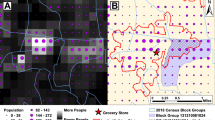Abstract
This research addresses estimations of distance, an important factor in numerous consumer decisions (e.g., store choice, willingness to pay for travel). Our central hypothesis is that when two places are located in the same geographic category, individuals estimate them to be closer to each other than when they are located in different categories, a bias we term “the out-of-region bias.” In study 1, we demonstrate that participants are more willing to visit a store located in the city in which they live rather than a store located in a neighboring city because they mistakenly think that a store in their city is closer to home. In studies 2a and b, we show that the out-of-region bias leads consumers to express higher willingness to pay for an airline ticket that involves travel across versus within regions because they inaccurately estimate greater distance between cities that are located in different regions (vs. the same region). Study 2a also demonstrates that the out-of-region bias is ameliorated in the presence of a map, indicating that the bias is a conceptual (vs. perceptual) bias, and study 2b rules out an alternative explanation for our results based on consumers’ tendency to exaggerate north–south distances.



Similar content being viewed by others
Notes
The addresses provided to participants are real and were taken from the Home Depot website.
References
Allen, G. L., & Kirasic, K. C. (1985). Effects of the cognitive organization of route knowledge on judgments of macrospatial distance. Memory & Cognition, 13, 218–227.
Brown, N. R. (2002). Real-world estimation: Estimation modes and seeding effects. In B. H. Ross (Ed.), The psychology of learning and motivation: Advances in research and theory. Vol 41 (pp. 321–359). San Diego: Academic.
Burris, C. T., & Branscombe, N. R. (2005). Distorted distance estimation induced by a self-relevant national boundary. Journal of Experimental Social Psychology, 41, 305–312.
Burris, C. T., & Rempel, J. K. (2004). “It’s the end of the world as we know it”: Threat and the spatial-symbolic self. Journal of Personality and Social Psychology, 86, 19–42.
Carvalho, S. W., Block, L. G., Sivaramakrishnan, S., Manchanda, R. V., & Mitakakis, C. (2008). Risk perception and risk avoidance: The role of cultural identity and personal relevance. International Journal of Research in Marketing, 25, 319–326.
Coren, S., & Girgus, J. S. (1980). Principles of perceptual organization and spatial distortion: The gestalt illusions. Journal of Experimental Psychology: Human Perception and Performance, 6, 404–412.
Friedman, A. (2009). The role of categories and spatial cuing in global-scale location estimates. Journal of Experimental Psychology. Learning, Memory, and Cognition, 35, 94–112.
Friedman, A., & Brown, N. R. (2000a). Updating geographical knowledge: Principles of coherence and inertia. Journal of Experimental Psychology. Learning, Memory, and Cognition, 26, 900–914.
Friedman, A., & Brown, N. R. (2000b). Reasoning about geography. Journal of Experimental Psychology: General, 129, 193–219.
Friedman, A., & Montello, D. R. (2006). Global-scale location and distance estimates: Common representations and strategies in absolute and relative judgments. Journal of Experimental Psychology. Learning, Memory, and Cognition, 32, 333–346.
Friedman, A., Brown, N. R., & McGaffey, A. P. (2002a). A basis for bias in geographical judgments. Psychonomic Bulletin & Review, 9, 151–159.
Friedman, A., Kerkman, D. D., & Brown, N. R. (2002b). Spatial location judgments: A cross-national comparison of estimation bias in subjective North American geography. Psychonomic Bulletin & Review, 9, 615–623.
Goldstone, R. L. (1994). The role of similarity in categorization: Providing a groundwork. Cognition, 52, 125–157.
Gregan-Paxton, J., Hoeffler, S., & Zhao, M. (2005). When categorization is ambiguous: Factors that facilitate the use of a multiple category inference strategy. Journal of Consumer Psychology, 15, 127–140.
Huff, D. L. (1963). A probabilistic analysis of shopping center trade areas. Land Economics, 39, 81–90.
Huff, D. L. (2003). Parameter estimation in the Huff model. ArcUser, October–December, 34–36.
Huff, D. L., & Rust, R. T. (1984). Measuring the congruence of market areas. Journal of Marketing, 48, 68–74.
Judd, C. M., Kenny, D. A., & McClelland, G. H. (2001). Estimating and testing mediation and moderation in within-subject designs. Psychological Methods, 6, 115–134.
Kang, Y., Herr, P. M., & Page, C. M. (2003). Time and distance: Asymmetries in consumer trip knowledge and judgments. Journal of Consumer Research, 30, 420–429.
Krishna, A. (2007). Biases in spatial perception: A review and integrative framework. In M. Wedel & R. Peters (Eds.), Visual marketing: From attention to action (pp. 162–192). Mahwah: Erlbaum.
Nelson, L., & Simmons, J. P. (2009). On southbound ease and northbound fees: Literal consequences of the metaphoric link between vertical position and cardinal direction. Journal of Marketing Research, 46, 715–724.
Raghubir, P., & Krishna, A. (1996). As the crow flies: Bias in consumers’ map-based distance judgments. Journal of Consumer Research, 23, 26–39.
Ratneshwar, S., Barsalou, L. W., Pechmann, C., & Moore, M. (2001). Goal-derived categories: The role of personal and situational goals in category representations. Journal of Consumer Psychology, 10, 147–157.
Rosch, E. (1973). Natural categories. Cognitive Psychology, 4, 328–350.
Saarinen, T., Parton, M., & Billberg, R. (1996). Relative size of continents on world sketch maps. Cartographica, 33, 37–47.
Snyder, J. P. (1993). Flattening the earth: Two thousand years of map projections. Chicago: University of Chicago Press.
Soman, D., & Shi, M. (2003). Virtual progress: The effect of path characteristics on perceptions of progress and choice. Management Science, 49, 1229–1250.
Tversky, B. (1981). Distortions in memory for maps. Cognitive Psychology, 13, 407–433.
Author information
Authors and Affiliations
Corresponding author
Rights and permissions
About this article
Cite this article
Irmak, C., Naylor, R.W. & Bearden, W.O. The out-of-region bias: Distance estimations based on geographic category membership. Mark Lett 22, 181–196 (2011). https://doi.org/10.1007/s11002-010-9120-3
Published:
Issue Date:
DOI: https://doi.org/10.1007/s11002-010-9120-3




